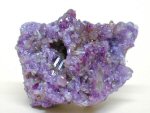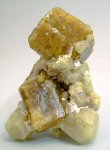|
| Home | Crystal | jmol | jPOWD | Chem | X Ray | Dana | Strunz | Properties | A to Z | Images | Share | News | Help | About |
General Vesuvianite Information
Vesuvianite Image

|
Comments: Clear, purple vesuvianite crystals. |

|
Comments: Blocky, tan-colored vesuvianite with white grossular (garnet). |
Vesuvianite Crystallography
Mouse
Dbl Clk - Start-Stop Rotation
RMB - Cycle Display Modes
Drag1 - Manipulate Crystal
Drag2 - Resize
Keyboard
S - Stereo
I - Indicies
<space> - Start-Stop Rotation
F - Fit to Screen
M - Menu
Help on Above
| Forms:
( 1 1 1)
( 1 1 0)
( 0 0 1)
Warning: this large pop-up is very compute intensive and may not work well with some computers. |
Mouse
drag1 - LMB Manipulate Structure
drag2 - RMB Resize/Rotate
Keyboard
S - Stereo Pair on/off
H - Help Screen
I - Data Info
A - Atoms On/Off
P - Polyhedra On/Off
B - Bonds On/Off
Help on Above
[1] [10] [11] [12] [13] [14] [15] [16] [17] [18] [19] [2] [20] [21] [22] [23] [24] [3] [4] [5] [6] [7] [8] [9] |
Physical Properties of Vesuvianite
Optical Properties of Vesuvianite
CI calc= -0.021 (Excellent) - where the CI = (1-KPDcalc/KC)
KPDcalc= 0.2161,KPDmeas= 0.2116,KC= 0.2115
Ncalc = 1.7 - 1.73
Calculated Properties of Vesuvianite
note: Specific Gravity of Vesuvianite =3.40 gm/cc.
Boson Index = 0.99
U=PEVesuvianite x rElectron Density= 15.06 barns/cc.
Vesuvianite is Not Radioactive
Vesuvianite Classification
Other Vesuvianite Information
1 - Alkali-Nuts(English)
2 - Alkali-Nuts(Francais)
3 - Am. Min. Crystal Structure Database
4 - Amethyst Galleries' Mineral Gallery
5 - Athena
6 - CalTech Mineral Spectroscopy
7 - EUROmin Project
8 - Ecole des Mines de Paris
9 - Franklin Minerals(Dunn)
10 - Franklin Minerals(Palache)
11 - GeoScienceWorld
12 - Glendale Community College
13 - Google Images
14 - Google Scholar
15 - Handbook of Mineralogy (MinSocAm)
16 - Handbook of Mineralogy (UofA)
17 - HyperPhysics
18 - MinDAT
19 - Mineralienatlas (Deutsch)
20 - Minerals in Thin Section-University of North Carolina
21 - Online Mineral Museum
22 - QUT Mineral Atlas
23 - Ruff.Info
24 - Scandinavian mineral gallery
25 - UCLA - Petrography Thin-Sections
26 - WWW-MINCRYST
27 - YupRocks
28 - theimage
Search for Vesuvianite using:
Visit our Advertisers for Vesuvianite :
A Bijoux Google Search for VesuvianiteAdam's Minerals Google Search for Vesuvianite
Cape Minerals Google Search for Vesuvianite
Dakota Matrix Minerals Google Search for Vesuvianite
Excalibur Mineral Corp. Google Search for Vesuvianite
Exceptional Minerals Google Search for Vesuvianite
John Betts Fine Minerals Search for Vesuvianite
McDougall Minerals Google Search for Vesuvianite
Mineral News Website Link
Rock and Mineral Shows Google Search for Vesuvianite
Weinrich Minerals, Inc. Google Search for Vesuvianite
Ask about Vesuvianite here :
Ask-A-Mineralogist from the Mineralogical Society of America
Mindat.org's Discussion Groups
Original Rockhounds Discussion Group
Rockhounds Discussion Group on Yahoo Groups
Mineral Discussion Forum from Fabre Minerals - also available in
Espaņol
Print or Cut-and-Paste your Vesuvianite Specimen Label here :
|
Vesuvianite Ca10Mg2Al4(SiO4)5(Si2O7)2(OH)4Dana No: 58.02.04.01 Strunz No: 09.BG.35 Locality:
Notes:
|
